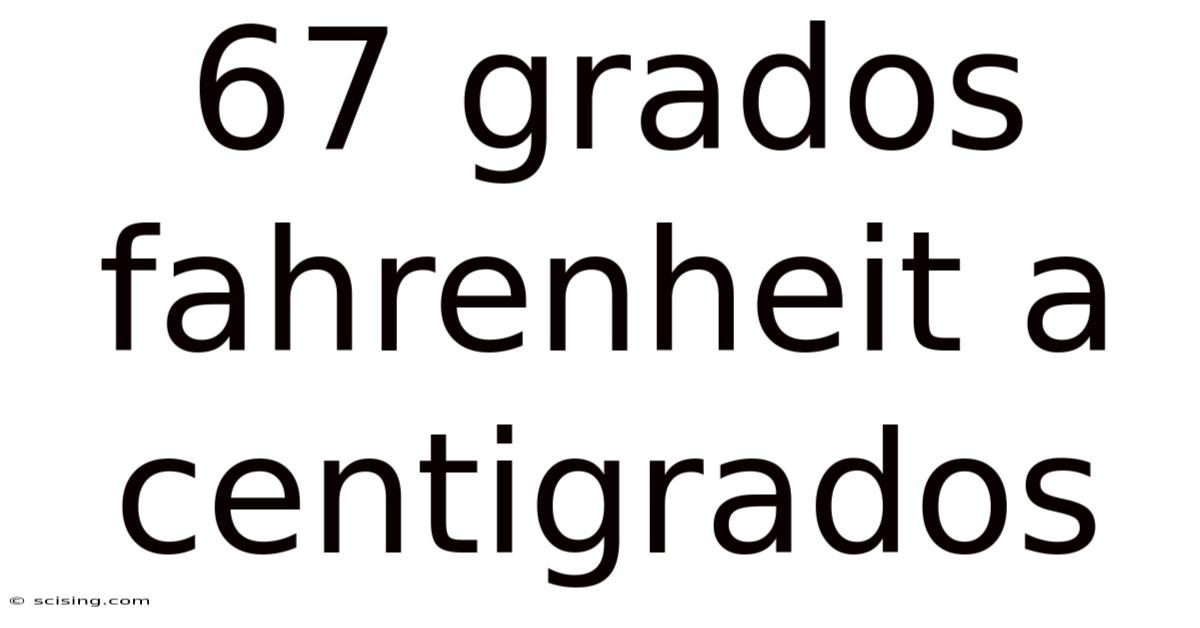67 Grados Fahrenheit A Centigrados
scising
Sep 05, 2025 · 4 min read

Table of Contents
67 Degrees Fahrenheit to Celsius: A Comprehensive Guide
Converting between Fahrenheit and Celsius is a common task, whether you're checking a weather forecast, adjusting an oven temperature, or understanding scientific data. This article provides a thorough explanation of how to convert 67 degrees Fahrenheit (°F) to Celsius (°C), along with the underlying principles, practical applications, and frequently asked questions. Understanding this conversion is crucial for anyone dealing with temperature measurements in various contexts. We'll delve into the mathematical formula, provide step-by-step instructions, and explore the significance of this specific temperature point.
Understanding the Fahrenheit and Celsius Scales
Before jumping into the conversion, let's briefly understand the two temperature scales. The Fahrenheit scale, developed by Daniel Gabriel Fahrenheit in the early 18th century, sets the freezing point of water at 32°F and the boiling point at 212°F, with 180 degrees separating them. The Celsius scale, also known as the centigrade scale, is a more widely used system internationally. It sets the freezing point of water at 0°C and the boiling point at 100°C, with 100 degrees separating them. This makes the Celsius scale more intuitive for many.
The Conversion Formula: Fahrenheit to Celsius
The fundamental formula to convert Fahrenheit to Celsius is:
°C = (°F - 32) × 5/9
This formula takes the Fahrenheit temperature, subtracts 32 (to adjust for the difference in freezing points), and then multiplies the result by 5/9 (to account for the different degree intervals).
Converting 67°F to Celsius: A Step-by-Step Guide
Now, let's apply the formula to convert 67°F to Celsius:
-
Subtract 32: 67°F - 32°F = 35°F
-
Multiply by 5/9: 35°F × (5/9) = 19.44°C (approximately)
Therefore, 67 degrees Fahrenheit is approximately 19.44 degrees Celsius.
The Significance of 19.44°C (Approximately)
A temperature of 19.44°C is considered a pleasant, mild temperature for many people. It falls within a range often described as "room temperature," though the ideal room temperature can vary based on personal preference and activity level. This temperature is often comfortable for indoor environments, particularly during spring or autumn. It’s neither too hot nor too cold, making it suitable for various activities and settings.
Practical Applications of Fahrenheit to Celsius Conversion
The ability to convert between Fahrenheit and Celsius is essential in numerous fields:
-
Meteorology: Weather reports often provide temperatures in both Fahrenheit and Celsius, requiring conversion for understanding and comparison.
-
Cooking: Recipes might use either scale, necessitating conversion to ensure accurate results. Understanding temperature conversions is crucial for baking, where precise temperatures are vital for successful outcomes.
-
Science and Engineering: Many scientific experiments and engineering applications utilize the Celsius scale, making conversion necessary when working with data from different sources.
-
Medicine: Body temperature is often measured in both scales, requiring accurate conversion for diagnosis and treatment.
-
International Travel: Different countries use different temperature scales predominantly. Understanding conversions is essential when traveling internationally and interpreting local weather information.
Beyond the Basic Conversion: Understanding the Relationship
The conversion formula is more than just a mathematical equation; it reveals the fundamental relationship between the two scales. The factor 5/9 highlights the difference in the size of a degree on each scale. A Celsius degree is larger than a Fahrenheit degree, reflecting the smaller range between the freezing and boiling points of water in the Celsius scale.
Addressing Common Misconceptions
A common mistake is reversing the order of operations or incorrectly applying the multiplication factor. Always follow the order of operations (subtraction first, then multiplication) to ensure accurate results. Another misconception is assuming a simple linear relationship – the conversion is not a simple multiplication but involves an offset (subtracting 32).
Frequently Asked Questions (FAQ)
Q1: Why are there two different temperature scales?
A1: Historically, different scales developed independently, reflecting different scientific and practical needs. While Celsius is the internationally preferred scale for scientific purposes, Fahrenheit remains common in some countries for everyday use.
Q2: Can I use an online converter instead of the formula?
A2: Yes, many online converters are readily available. However, understanding the underlying formula is beneficial for building a deeper understanding of temperature measurement and conversion.
Q3: Is there a formula to convert Celsius to Fahrenheit?
A3: Yes, the reverse formula is: °F = (°C × 9/5) + 32
Q4: What are some common temperature equivalents to remember?
A4: While memorizing all conversions isn't necessary, remembering key points like 0°C = 32°F (freezing point of water) and 100°C = 212°F (boiling point of water) can be helpful.
Q5: Are there any other temperature scales?
A5: Yes, besides Fahrenheit and Celsius, the Kelvin scale is widely used in scientific applications. Kelvin is an absolute temperature scale, where 0 K represents absolute zero, the theoretical point of zero thermal energy.
Conclusion
Converting 67°F to Celsius, resulting in approximately 19.44°C, illustrates a fundamental concept in temperature measurement. Understanding the conversion formula and its implications extends beyond a simple mathematical exercise. It provides a crucial tool for navigating various aspects of daily life, scientific endeavors, and international communication where temperature plays a vital role. Mastering this conversion empowers you to interpret temperature information accurately and confidently across diverse applications. Remember the steps, understand the underlying principles, and you'll be well-equipped to tackle any Fahrenheit-to-Celsius conversion with ease.
Latest Posts
Latest Posts
-
Power Of A Product Rule
Sep 05, 2025
-
She Walks In Beauty Analysis
Sep 05, 2025
-
Casualty Definition Ap World History
Sep 05, 2025
-
Ecology Animation On Population Dynamics
Sep 05, 2025
-
Is 21 Prime Or Composite
Sep 05, 2025
Related Post
Thank you for visiting our website which covers about 67 Grados Fahrenheit A Centigrados . We hope the information provided has been useful to you. Feel free to contact us if you have any questions or need further assistance. See you next time and don't miss to bookmark.